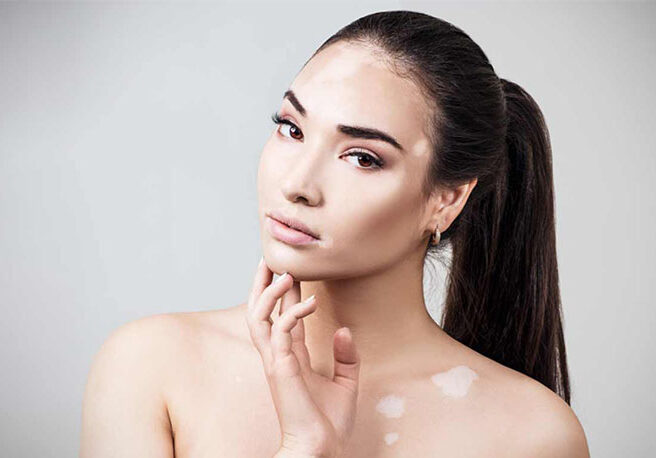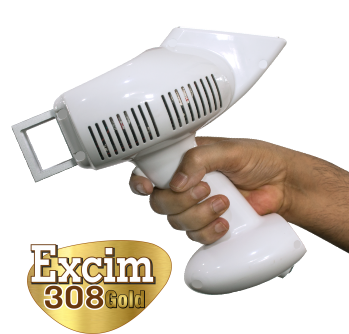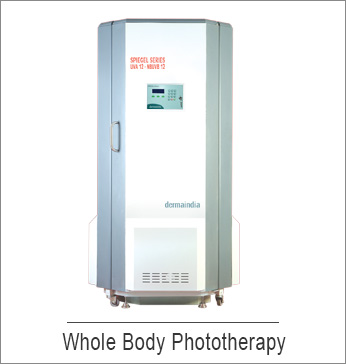
PHOTOTHERAPY TREATMENT
The use of ultraviolet light in the treatment of photo-responsive skin diseases is time tested!!
In olden days, the sunlight was the only source of light which showed that light could heal many conditions. Phototherapy, also known as light therapy, is using therapeutic UV rays to treat specific skin conditions. There are different types of light of phototherapy lights available to treat different conditions. Photo-chemotherapy is combined use of drug psoralen and UV-A radiation.
Use of ultraviolet light in the treatment of photo-responsive skin diseases is time tested, safe and effective. Advances in our understanding of the pathogenesis of skin diseases has resulted in the development of new phototherapeutic modalities such as long-wave UVA (UVA1), narrowband UVB, broadband UVB, EXCIMER 308nm and Photodynamic Therapy
Narrow band UVB is the gold standard for the treatment of skin conditions like Psoriasis, Atopic Dermatitis, Eczema, Vitiligo, Mycosis fungoides, Morphea, Prurigo nodularis, Severe Recalcitrant Pruritus etc.


PHOTOTHERAPY TREATMENT PROTOCOLS
Phototherapy involves the controlled exposure of the skin to ultraviolet (UV) or visible light. This exposure is carefully monitored and tailored to treat specific skin conditions and other medical issues. Phototherapy is commonly used to manage conditions such as psoriasis, eczema, vitiligo, and even some types of skin cancer.
Anyone can receive a phototherapy procedure if their dermatologist prescribes it as a treatment for their diagnosis. The candidate’s treatment protocol is set according to the location, the extent of disease, activity and type. Adults and as well as children can receive phototherapy treatment.
PUVASOL and PUVA therapy:
Psoralen ultraviolet-A or PUVA, combines UVA light with chemical called psoralen, which is plant derivative. Oral and topical psoralen followed by sun-exposure or UVA phototherapy is used in conditions like Alopecia areata, Atopic Dermatitis, Vitiligo, Lichen Planus etc.
UV-B:
This involves using more intense and smaller part of UVB to treat skin conditions. There are two types i.e, broadband (310-315nm) and narrowband (311nm) UVB, which is used in Vitiligo, Psoriasis, Atopic Dermatitis etc. NB-UVB has largely replaced BB-UVB because of its great effectiveness and safety. Here at FMS SKIN we use fluorescent lamp (TL01, Philips Lighting Company) which has a narrow emission spectrum centered around 311nm. It usually requires 2-3 treatments each week.
EXCIMER LIGHT AND LASER:
Also called as targeted phototherapy. It delivers more focused ultraviolet light to smaller areas of your body. After exposing the area to be treated, a light laser beam is passed over a small area of your skin that needs treatment. It is usually given twice a week and fewer sessions are required to clear the lesions.
Here at FMS, We Excimer Light device with 308nm for vitiligo, psoriasis, prurigo nodularis, atopic dermatitis, localised scleroderma, granuloma annulare, pityriasis alba, genital lichen sclerosis, to deliver high energy at the discrete affected areas, which is painless, and valuable treatment option when challenging diverse skin disorders both in terms of efficacy and safety.
PHOTO DYNAMIC THERAPY:
The aim of the therapy is to destroy the desired target selectively, thereby avoiding damage to vital structures. It is a two staged treatment that combines drug (photosensitiser) and light energy to destroy pre-cancer and cancer cells at target site after light activation.
After a phototherapy procedure, you can resume your daily activities. After treatment it is advised to protect your skin from further UV exposure, especially from the sun. You may experience some skin redness, rash or pigmentation, this may go away after 24 hours. It takes multiple sessions to see results on your skin.
Here at FMS Skin and Hair Clinics, we use NB-UVB and UVA chamber which contain Philips TL-01 lamp with an emission spectrum between 311-312nm which gives increased therapeutic effect which is known to be safer in vitiligo, psoriasis and other inflammatory conditions. Advantages of NB UVB is easier to use, has great effectiveness, is cheap with no GIT disturbance, and great safety profile.
